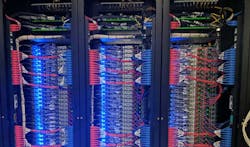As 2019 comes to a close, Data Center Frontier is taking a look back at some of the key trends and top stories to hit the data center market over the past 12 months. One of these trends was the development of edge computing. DCF Editor Rich Miller wrote that “2019 was a year of laying the groundwork for future growth.”
Throughout the year, the market began to sort out the business models surrounding edge computing and colo, and companies raised funding and began deploying capacity across a variety of new markets, to name a few factors driving the push.
As the data center industry enters a new decade, further focus on the edge is expected as companies work toward bringing services closer to the end user. Here are some of the significant stories from Data Center Frontier’s edge computing coverage in 2019, highlighting emerging trends and companies making big splashes at the edge.
Key Edge Computing Trends
Explore the ins and outs of the race to 5G, as well as the potential of new edge devices.
The 5G Rollout: The Hype is Building Faster Than the Infrastructure: Data center and telecom professionals say that 5G will indeed be a huge deal, but that the hype and publicity around 5G is getting ahead of the infrastructure needed to deliver it.
What 5G Will Mean to the Data Center Industry: 5G wireless is expected to increase the volume of mobile data. Here’s a closer look at the timing of the 5G rollout and what all that data traffic will mean for data centers.
If 5G succeeds, it will be easier to move data between locations, a trend that has always been good for the data center business.
Facets of the Edge: The Raspberry Pi as an Edge Device: Edge applications will require new thinking, and efficient use of resources. Here’s a look at how SWIM.AI uses lightweight hardware to power edge AI for real-time traffic management.
The AWS Cloud Extends to the Edge, With Likely Boost for Colo Operators: As Amazon Web Services extends its cloud into edge computing, it will be deploying more servers with colocation providers & telcos. Here’s a closer look at AWS Local Zones and their potential impact on the edge computing sector.
Roundtable: Edge Computing Will Gain Momentum in 2020: There’s broad agreement that edge computing will make an important expansion of IT architecture? But what will 2020 adoption look like at the edge? Our DCF Executive Roundtable offers their predictions.
Top Companies Making Moves on the Edge
The latest in edge news from edge, colo and data center leaders like Equinix, EdgeConnex, Vapor IO and more.
A Vapor Edge Module with a Hangar drone system mounted on the top of the modular data center. (Image: Vapor IO)
Vapor IO Forms Alliance to Move Faster on Edge Deployments: Edge computing specialist Vapor IO has organized the Kinetic Edge Alliance, a group of hardware, software and networking companies that will collaborate on edge solutions.
EdgeMicro Readies its Micro Data Center Platform for Edge Growth : Edge computing specialist EdgeMicro has completed a $3 million round of funding, which will move it beyond the proof-of-concept stage to begin deploying data center modules in production.
Packet Takes Its ‘Go Anywhere’ Cloud to the Edge: Packet is bringing its “go anywhere” bare metal cloud to Detroit, where it will work with EdgeConneX to expand Sprint’s Curiosity IoT infrastructure to support the auto industry.
Equinix Eyes the Edge.And the Cloud. And the Enterprise: In 2019 , Equinix is focusing on opportunities in hyperscale data centers and enterprise computing, while sizing up where it may want to play in edge computing.
EdgeConneX Ready for the Next Phase of Edge Computing: Edge computing pioneer EdgeConneX has expanded into hyperscale projects, but says it intends to be a key player as next-generation technologies drive growth in edge deployments.
Compass Sees Opportunity in Building Better Networks: Compass EdgePoint is targeting network performance as a growth opportunity in its edge computing business, seeking to support data flows from industrial IoT applications.
Life on the Edge: Distributed Networks and the Need for Access and Control: Vertiv explores distributed networks, and how access, control and full visibility is key for success. Patrick Quirk highlights technology like serial consoles, available to enable and simplify remote management of distributed networks and IT sites.
Keep pace with the fact-moving world of data centers, edge computing and more by following us on Twitter and Facebook, connecting with Data Center Frontier editor Rich Miller on LinkedIn, and signing up for our weekly newsletter using the form below.



